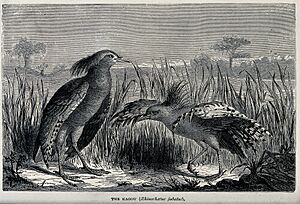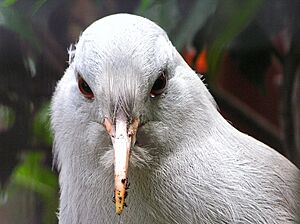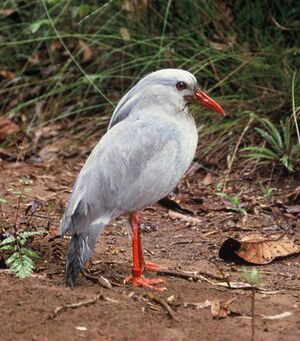Kagu facts for kids
Quick facts for kids Kagu |
|
|---|---|
 |
|
| Conservation status | |
| Scientific classification |
The kagu (also called cagou) is a unique bird found only in the mountain forests of New Caledonia. It has a crest, long legs, and a bluish-grey color. This bird is the only living member of its family, the Rhynochetidae.
Kagus are about 55 cm (22 inches) long. They have light grey feathers and bright red legs. A special feature is their 'nasal corns', which are small covers over their nostrils. No other bird has these! Kagus can barely fly. They spend most of their time on the ground, hunting small creatures. They build their nests from sticks on the forest floor. Both parents take turns sitting on the single egg and raising the chick. Sadly, kagus are in danger because of animals brought to New Caledonia by humans.
Contents
What's in a Name?
The name "kagu" comes from the local Melanesian languages spoken in New Caledonia. People there call the bird kavu or kagou. In French, it's known as cagou, which is also used in English.
The scientific name, Rhynochetos jubatus, has a special meaning. Rhynochetos comes from ancient Greek words for "nose" and "long hair." This refers to the long, stiff hairs near its nostrils. The word jubatus is Latin for "crested," describing its head feathers.
Kagu's Family Tree

For a long time, scientists weren't sure where the kagu fit in the bird family tree. It was a bit of a mystery! They often grouped it with birds like cranes. This was because kagus have special "powder down" feathers, similar feather colors, and similar eggs and chicks.
Today, scientists believe the kagu's closest living relative is the sunbittern. This bird lives far away in Central and South America. Both the kagu and sunbittern seem to be part of an ancient bird group from a supercontinent called Gondwana. This suggests their ancestors separated millions of years ago. Kagu ancestors likely arrived in New Caledonia between 60 and 25 million years ago. Since there were no land predators, they slowly lost the ability to fly.
Scientists have also found bones of a larger, extinct kagu species. This "lowland kagu" was about 15% bigger than the kagu we see today. It lived in lower areas of New Caledonia. This larger kagu disappeared after humans arrived on the island.
Kagu's Unique Look
The kagu is a ground-dwelling bird, about 55 cm (22 inches) long. Its weight can change with the seasons, from 700 to 1100 grams (25 to 39 ounces). Its feathers are a striking ash-grey and white, which is unusual for a forest bird. Male and female kagus look very similar.
Kagus have special "powder down" feathers. These help keep them dry and warm in New Caledonia's tropical weather. They also have a crest of feathers on their head. This crest usually lies flat but can be raised and fanned out when the bird wants to show off.
Wings and Legs
Kagus are almost flightless. They use their wings for special displays and to move quickly through the forest. They can also glide a short distance if they need to escape danger. Even though they don't fly, their wings are not small. They have a wingspan of about 77.5 cm (30.5 inches). However, they don't have the strong muscles needed for flight.
Their wings are also used for a "broken-wing" display. This is when a kagu pretends to be hurt to distract a predator away from its chick. Their bright red legs are long and strong. This helps them travel long distances on foot and run very fast.
Special Features
Kagus have large eyes that help them see well in the dim forest. Their eyes are positioned to give them good binocular vision, which is great for finding prey in the leaf litter.
A very unique feature is their 'nasal corns'. These are structures that cover their nostrils. Scientists think these prevent dirt from getting into their noses when they poke around in the soil for food. Another unusual thing about kagus is their blood. They have fewer red blood cells than most birds but three times more hemoglobin in each cell.
Where Kagus Live
Kagus live only in the forests and shrublands of New Caledonia. Specifically, they are found on the main island, called Grande Terre. They can live in many different types of forests, as long as there is enough food. This includes rainforests and drier lowland forests. They can also be found in some dry shrublands.
However, kagus avoid areas with too much ground cover, like grasslands. This makes it hard for them to find food. Their living areas have shrunk over time because of hunting and new animals brought to the island.
Kagu's Daily Life
Kagus are very protective of their homes. They have territories that they defend all year round, usually covering about 10 to 28 hectares (25 to 69 acres). Kagu families often consist of one breeding female and one to three breeding males. Young male kagus sometimes stay with their parents and help protect the family's territory.
Kagus make many different sounds. They often sing together in the morning, with each song lasting about 15 minutes. They use their crest and wings to show other kagus who's boss. They have different displays for predators. If two kagus fight over territory, they use their wings and bills. These fights rarely cause serious injuries.
What Kagus Eat
Kagus are meat-eaters. They mainly eat annelid worms, snails, and lizards. They also enjoy larvae, spiders, centipedes, and insects like grasshoppers and beetles. Most of their food comes from the leaf litter or soil. They might also find prey in plants, old logs, or under rocks. Sometimes, they even hunt small animals in shallow water.
Their hunting style is to stand very still and watch for movement. They might stand on one foot and gently move leaves with the other to scare out prey. Once they spot something, they quickly move towards it and strike with their bill. They don't use their feet to dig for food.
Reproduction and Life Cycle
Kagus usually stay with the same partner for many years, possibly for their whole lives. They can live for a long time, sometimes over 20 years in zoos. They try to nest once a year. If their first nesting attempt fails, they might try again.
Their nest is very simple, just a pile of leaves. Sometimes, the egg is laid directly on the ground. The nest is not hidden but is usually near a tree trunk or log. They lay a single grey egg with some blotches, weighing about 60–75 grams (2.1–2.6 ounces).
Both parents share the job of incubating (sitting on) the egg. Each parent takes a 24-hour shift, changing over around noon. They stay on the egg almost all the time. The egg takes a long time to hatch, about 33 to 37 days.
Young kagus might stay with their parents for many years after they can fly, sometimes up to six years. These older chicks don't help with incubating or raising new chicks. However, their presence seems to help their parents have more successful nests. They also help defend the family's territory. Kagus have even been seen adopting chicks that are not their own. This is rare but happens in species that have few young and take great care of them.
Saving the Kagu
The kagu population first dropped because people hunted them for food. They were also caught for the pet trade and for museums. Today, the biggest threats are animals brought to New Caledonia by humans, like cats, pigs, and dogs. Before humans arrived, New Caledonia had almost no mammals. Many native species are not used to these new predators. Rats, for example, cause 55% of chick losses. Kagus also lose their homes due to mining and forestry.
People started worrying about the kagu's future as early as 1904. In the 1990s, a study showed how much dogs were harming kagu populations. The kagu is now listed as endangered and is fully protected in New Caledonia.
There are special efforts to save the kagu. They breed well in the Nouméa Zoo. They are also doing well in Rivière Bleue Territorial Park, which has a program to control pests. Captive-bred kagus have been released into the wild there.
Recent studies show that natural heavy metals in the soil might affect kagus. Kagus in areas with low heavy metal levels laid more eggs and had more chicks. They also had smaller home ranges and were heavier. This suggests that conservation efforts might work best in areas with low heavy metal levels in the soil.
Kagus and People
The kagu has always been important to the Kanak people, the native people of New Caledonia. In some tribes, the kagu's name was given to people. Its crest was used in the head-dresses of chiefs. Its calls were even part of war dances and seen as messages from the chiefs. Some Kanak people called the kagu the "ghost of the forest."
Europeans didn't discover the kagu until 1852. A kagu was shown at an exhibition in Paris in 1860, which made many scientists interested. This led to many kagus being caught for museums and zoos. Europeans also hunted kagus for food, considering them a special treat. It was also popular to keep kagus as pets. A campaign was run from 1977 to 1982 to stop the pet trade.
Today, the kagu is a very important symbol for New Caledonia. Its unique song used to be played on the island's TV station every night when it signed off. Saving the kagu is seen as important for the island's economy and image.
See also






